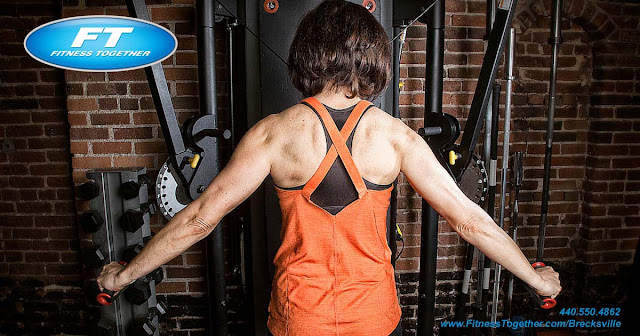Trainer Tuesdays
Welcome back to the weekly edition on Trainer Tuesdays. Make sure to check in at our blog every Tuesday evening to learn the expertise of our great staff of expert personal trainers. Aside from being fantastic exercise coaches, they are also extremely knowledgeable in many aspects of health and fitness; so, it's time that you get to know them a little better! Each week, we will post a frequently asked, or sometimes just a fun fitness related question followed by the answers of each of the personal trainers at Fitness Together Brecksville.
If I’m Not Sore, Does That Mean it Was Not an Effective Workout?
Amanda Ricci: "No
pain, no gain" is a common myth that is continued to be believed by many
gym goers today. They believe that unless you're really sore the next day or
two after a workout that that means the workout wasn't effective. This soreness
is also referred to as DOM's, or delayed onset muscle soreness and it can occur
anywhere from 6 to 48 hours after a workout. DOMs is the microtrauma in
the muscles and surrounding connective tissue that causes
inflammation.
The good news is that you don't have to be crippled the next day after a
workout to have received a great workout. Your level of soreness
following a workout should not be used to indicate that you had an effective
session at the gym or with your trainer. Some people based on their genetics
vary as to how sore they will be following a workout. If you
are sore it is indicative that you started a new training routine and
your muscles are starting to adapt to those exercises. Those muscles will
repair themselves following a workout and then become stronger. It is
important to give your muscles a break in between strength training workouts so
that they can recover. If your working with a trainer they can design a
more customizable program for you if they know that you like to work
out two days in a row to make sure that they work different muscle groups.
There are some dangers to
being too sore after a workout in that it can lead to repetitive injury
and over training. If your the type of individual that likes to consistently
change up your workouts this is something to be careful of since you need
to make sure your giving those muscles adequate time to recover in between
workouts and that your not experiencing any of the signs or symptoms of
overtraining. Some symptoms of overtraining include: irritability,
reduced ability to sleep at night, not feeling hungry and also lack of
motivation. In addition, you may feel constantly tired and achy.
Some ways to recover from DOMS
include: taking an Epsom salt bath, increasing protein intake (to increase
protein synthesis), sleep, foam rolling, and omega 3 supplementation
( to decrease inflammation).
Steven Madden: Soreness after a workout is the result
of small tears in the muscle fibers. We refer to this as delayed onset muscle
soreness, or DOMS for short. You usually feel these 24-48 hours after a
workout, and they are a sign of either high intensity, or a change in movement
routine. People don't always like being sore, but it is not necessarily a bad
thing. It's also not necessarily a good sign either. When you change your
routine, the first couple of times, you should get sore, however if this
persists, that might mean you are over training, or have even sustained an
injury. A workout without any soreness may just mean it will soon be time to
switch things up, but not that you didn't get a good workout.
Brooke Kratche: While
being sore can give you a good idea of the quality of workout you did, it is
not the only measure. Soreness is simply a result of the muscles finding energy
in other places than its immediate energy storage. It takes apart the compounds
and what is left is lactic acid which is what you feel when you are sore.
Not feeling sore just means your body had adequate energy stored up for your
workout. As your muscles grow, they create larger storage units for energy
meaning you need to do even more to feel soreness following the workout.
Therefore, don't feel like you had an inadequate workout if you are not sore
afterwards, just know your body is adapting and getting stronger!
Adam Teplitz: Muscle soreness is not
an indicator of an effective workout. Sore muscles does not mean you had an
effective or productive workout. On the other hand, not being sore does not
mean the workout wasn't effective. As far as effectiveness goes, muscle
soreness means nothing.
Muscle soreness occurs when you make them do something they're not used to doing. A new exercise, taking less rest between sets or an increase in weight lifted. Certain exercises that have more of a stretch component can lead to increase soreness as well.
The best indicator of whether your workouts are effective is progress, not muscle soreness. Are you getting stronger? Are your clothes fitting better?
Justin Traft: Client always ask if I am not sore was the
workout still effective. Great question . Here's my thoughts. I have trained
for a long time now. Not every workout do you need to barely be able to lift
your arms or sit on your seat afterwards. Honestly some of the most effective
workouts are the ones that don't have soreness after because you are either
doing a cardio movement exercise or a muscular endurance exercise resulting in
calorie burn or just good ole fashioned muscle burn. Not every person wants to
or needs to look like Arnold to get a effective workout. When your body is
motion and its working it always more then just sitting in your chair or
sitting on a couch. Your still doing your body good. Being active is key to
longevity in life! So don't always get caught up in how much you can curl or
how much you can squat because your still doing good for yourself! Now I am not
saying push yourself I am a firm believer in that. But give yourself credit
where credit it do!
Michael Roberto: When a person exercises,
they will sometimes experience soreness in their muscles. Overtime they
will become less sore. This does not mean that they had an ineffective
workout and should quit. It simply means that their body has adapted to
the demand of exercising with heavy weights or a change in the time you rest
between exercises. Ultimately, to gauge if your workouts are effective
will be the progress that you’re making. Can you lift more than you did
when you started? Have you lost weight? Things like that will tell
if your workouts are working.
© 2016 Fitness
Together, Inc. All Rights Reserved.
About | Contact | Franchise | Suppliers | History | Leadership | NutritionTogether |Sitemap| PrivacyPolicy | TermsofUse | Facebook | YouTube | Twitter | Linkedin | Yelp





